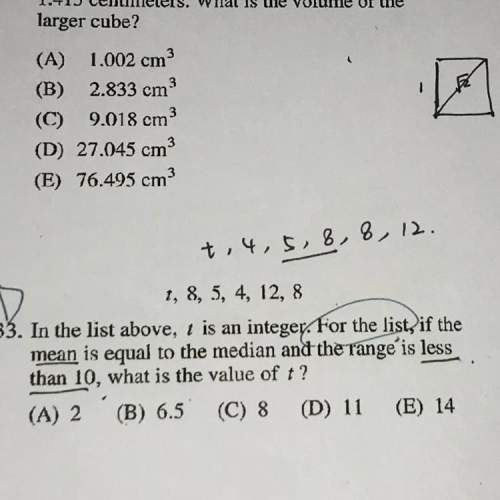
Mathematics, 19.02.2021 14:00 lizzoone
Besondere Zahlen und ihre Eigenschaften
Im Basiswissen-Kasten im Buch auf Seite 146 oben ist dargestellt, wie man zu den natürlichen Zahlen von
bis 10 die Summenzahlen, Quadratzahlen und Zweierpotenzzahlen berechnet. Lies die Buchseite
vollständig durch. Fülle dann die folgende Tabelle aus. Überlege jeweils, wie du die Zahlen aus der Zeile
darüber berechnen kannst. Beispiel A auf S. 146 kann dir bei den Quadratzahlen helfen.
Quadratzahlen
Zweierpotenzzahlen
Summenzahlen
21 = 2
12 = 1
1
1
22=2-2=4
22 = 2.2=4
1+2 = 3
2
2 = 2.2-2 = 4-2 = 8
31 = 3.3 = 9
3
3+3 = 6
16
16
6+4 = 10
4
5
15
6
7
8
9
10
11
12
13
14
15
32.768
Löse anschließend die Aufgabe 6 auf Seite 147. Du kannst dafür die folgende Tabelle benutzen.
Tipp: Schreibe die Zahlen zunächst nach Größe sortiert auf einen Notizzettel. Es sind 26 Zahlen,
von denen 6 weder Summen- noch Quadrat- oder Zweierpotenzzahlen sind.
Summenzahlen
Quadratzahlen
Zweierpotenzzahlen
Anzahl:
Anzahl:
Anzahl:

Answers: 3


Other questions on the subject: Mathematics


Mathematics, 22.06.2019 01:00, SpeechlessZzz9920
For every corresponding pair of cross sections, the area of the cross section of a sphere with radius r is equal to the area of the cross section of a cylinder with radius and height 2r minus the volume of two cones, each with a radius and height of r. a cross section of the sphere is and a cross section of the cylinder minus the cones, taken parallel to the base of cylinder, is the volume of the cylinder with radius r and height 2r is and the volume of each cone with radius r and height r is 1/3 pie r^3. so the volume of the cylinder minus the two cones is therefore, the volume of the cylinder is 4/3pie r^3 by cavalieri's principle. (fill in options are: r/2- r- 2r- an annulus- a circle -1/3pier^3- 2/3pier^3- 4/3pier^3- 5/3pier^3- 2pier^3- 4pier^3)
Answers: 3

Mathematics, 22.06.2019 03:00, TheOriginalMeyah
The biologist has a second culture to examine. she knows that the population of the culture doubles every 15 minutes. after 1 hour and 15 minutes, her assistant found that 80,000 bacteria were present. a) what was the size of the initial population? b) predict the size of the culture at t=3 hours. what was the size of the population at 40 minutes? explain and justify your answers. c) create a graph of the population as a function of time. find an equation that can be used to predict the size of the population at any time t. d) examine the rate at which the bacteria culture is growing. how fast is the culture growing after 1 hour? after 1.5 hours? after 2 hours? use a time interval of h = 0.01 hours to estimate these rates. interpret these rates in terms of the context of the problem situation. how do these three rates compare?
Answers: 1

Mathematics, 22.06.2019 03:10, erinleyanne
If f(x) = 5х – 2 and g(x) = 2х + 1, find (f – g)(x).
Answers: 1
You know the right answer?
Besondere Zahlen und ihre Eigenschaften
Im Basiswissen-Kasten im Buch auf Seite 146 oben ist darges...
Questions in other subjects:

Mathematics, 15.01.2021 02:30



Chemistry, 15.01.2021 02:30

English, 15.01.2021 02:30



Mathematics, 15.01.2021 02:30

English, 15.01.2021 02:30




